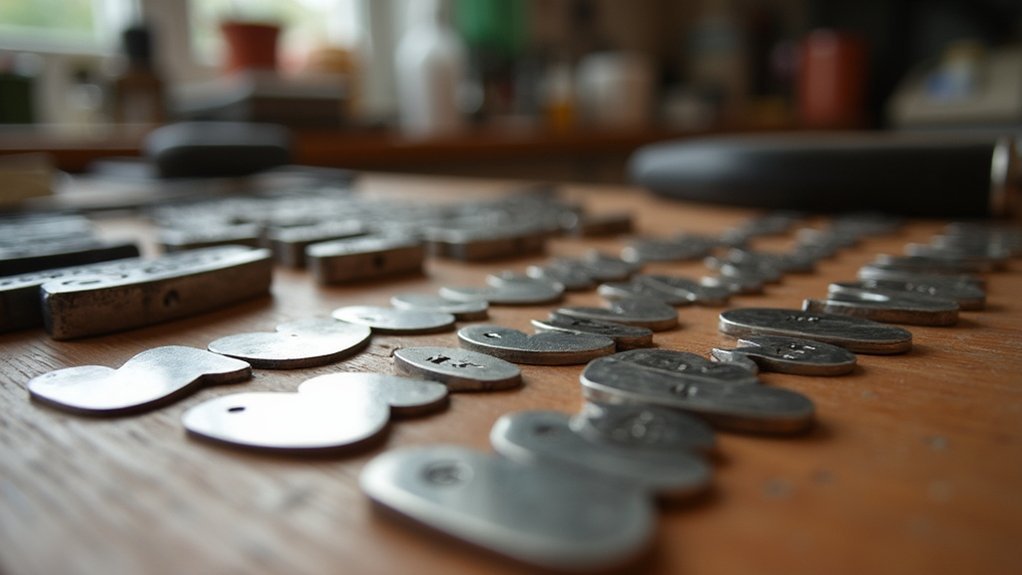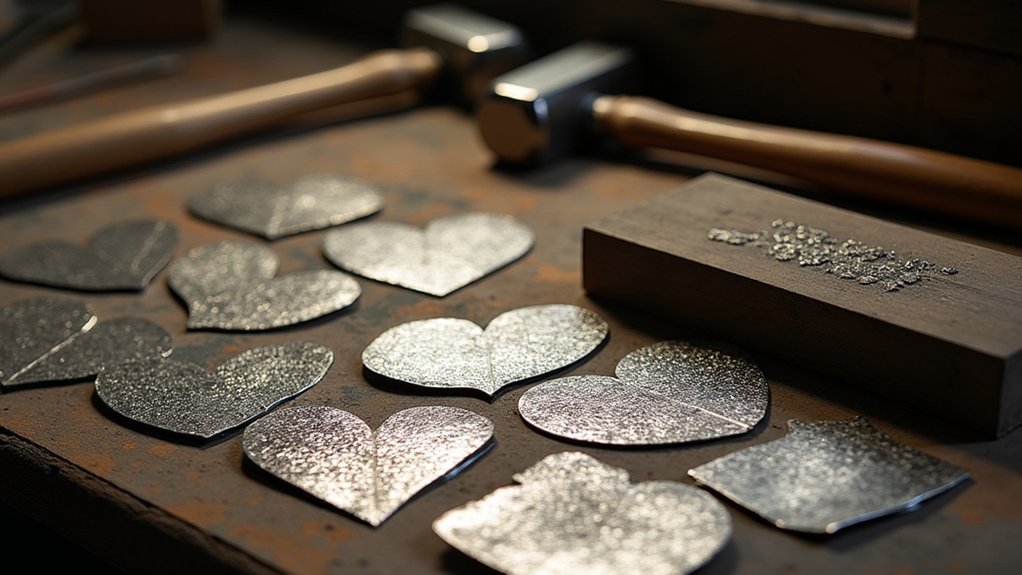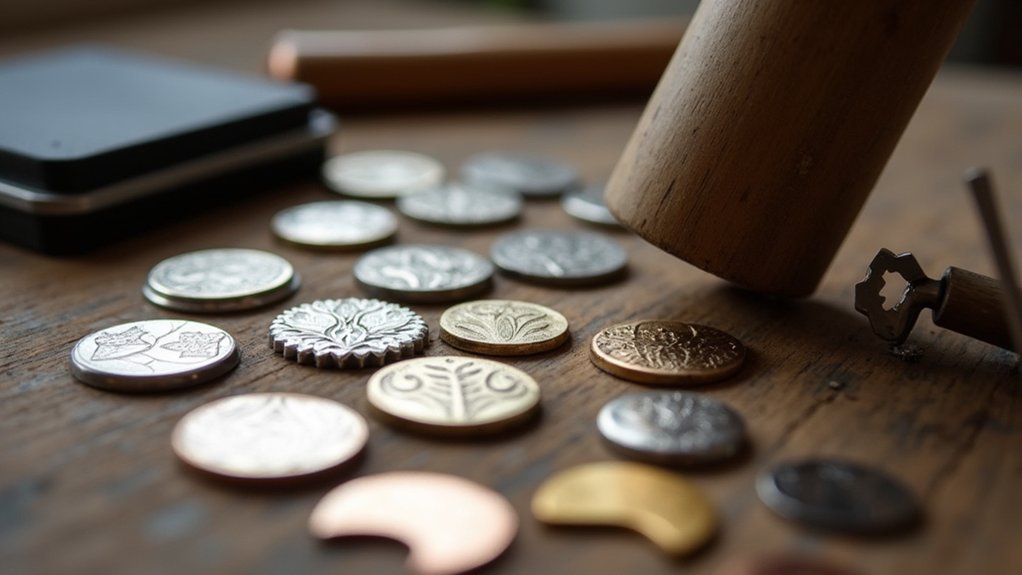You’ll master metal stamping quickly when you focus on three fundamental techniques that transform plain jewelry blanks into personalized masterpieces. Start with basic letter and number stamping using uppercase, lowercase, and number stamps on secured metal blanks. Next, create simple patterns with design stamps, using rulers for proper alignment and consistent spacing. Finally, enhance textures using chasing hammers and ball-peen hammers on dapping blocks to add dimensional effects. These core methods will reveal endless creative possibilities for your jewelry projects.
Basic Letter and Number Stamping on Metal Blanks

Metal stamping transforms plain metal blanks into personalized jewelry pieces through simple letter and number impressions.
You’ll need essential metal stamping supplies including metal stamps with uppercase, lowercase letters, and numbers for versatile personalized projects. Start by securing your metal blanks on a stamping block using masking tape to prevent movement during stamping.
Use your stamping hammer to strike each stamp firmly and directly, targeting the center for clear impressions. Developing a consistent striking rhythm takes practice, so work with practice blanks made from scrap aluminum sheets first. This helps you refine your technique and achieve even pressure.
Practice makes perfect when metal stamping – start with scrap aluminum to develop your striking technique before moving to final pieces.
Enhance your finished work by filling impressions with black Sharpie or stamping enamel, then wipe excess for a polished look that makes letters pop.
Simple Pattern Creation Using Design Stamps
After mastering basic letters and numbers, you’ll discover that design stamps open up endless creative possibilities for decorating your metal jewelry pieces.
Design stamps offer extensive decorative options, from intricate floral motifs to bold geometric patterns that transform plain metal blanks into stunning accessories.
Position your design stamp firmly against the metal surface and deliver a controlled strike with your stamping hammer. This technique guarantees clean, crisp impressions every time.
Use a ruler for proper alignment, creating consistent spacing between repeated patterns.
Practice on scrap metal first, experimenting with different pressure levels to achieve ideal depth and visibility.
Consider incorporating a dapping block to add dimensional curves to your stamped designs, elevating your jewelry’s visual appeal and professional quality.
Texture Enhancement With Hammer and Block Techniques

Three essential hammer types will revolutionize your metal stamping texture work: chasing hammers, ball-peen hammers, and rubber mallets.
Chasing hammers create distinctive textures on metal surfaces, expanding your design possibilities beyond basic stamping patterns. Ball-peen hammers produce unique impressions with their rounded heads, adding varied textures to your pieces.
Beyond basic stamping patterns, chasing and ball-peen hammers unlock distinctive textures and varied impressions for expanded metal design possibilities.
The dapping block techniques transform flat metal blanks into dimensional curved forms, creating visual depth in your jewelry.
You’ll control impression clarity by adjusting your hammering pressure—lighter strikes create subtle effects while firmer pressure produces bold, deep textures.
When working with softer metals like aluminum, use a rubber mallet instead of metal hammers. This protects your stamps from damage while still achieving excellent textured results on delicate materials, ensuring your tools last longer.
Frequently Asked Questions
What Is the Easiest Metal to Stamp?
You’ll find aluminum’s the easiest metal to stamp because it’s soft and lightweight. You can create clear impressions with less force, it’s cost-effective for practice, and it won’t tarnish over time.
What Do I Need to Start Metal Stamping?
You’ll need a metal stamping kit with stamps, hammer, and block. Get metal blanks in aluminum, brass, or copper. Add stamping tape, permanent markers, polishing cloths, and safety glasses to complete your setup.
What Are the Four Types of Metal Stamping?
You’ll encounter four main types of metal stamping: letter stamping for text and numbers, shape stamping for forms like hearts, design stamping for decorative patterns, and texture stamping for surface depth.
Do You Need a Special Hammer for Metal Stamping?
Yes, you’ll need a specialized stamping hammer for metal stamping. It provides better control, precision, and even force distribution compared to regular hammers, ensuring clean impressions while reducing mistakes and hand injuries.
In Summary
You’ve now learned three essential metal stamping techniques that’ll set you on the right path. Start with basic letter and number stamping to build your foundation, then move on to design stamps for creative patterns. Don’t forget to incorporate texture work with your hammer and block. Practice these methods consistently, and you’ll develop the confidence and skills needed to create beautiful, professional-looking stamped jewelry pieces that you’ll be proud to wear or gift.





Leave a Reply